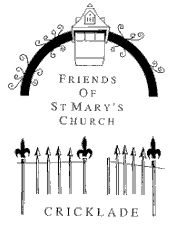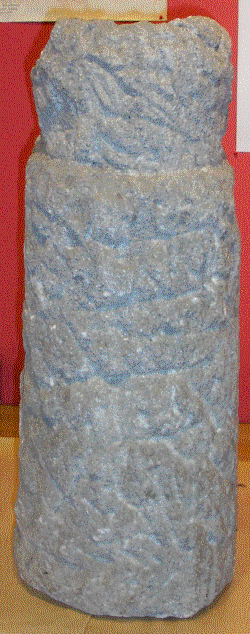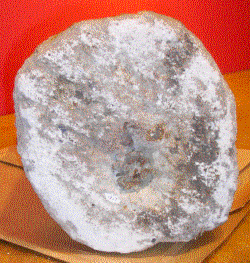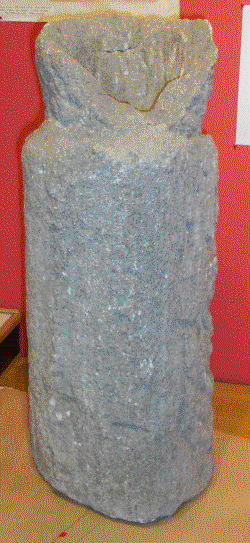


















 | |
[ Newsletter 14 ] [ Newsletter 13 ] [ Newsletter 12 ] [ Newsletter 11 ] [ Newsletter 10 ] [ Newsletter 9 ] [ Newsletter 8 ] [ Newsletter 7 ] [ Newsletter 6 ] [ Newsletter 5 ] [ Newsletter 4 ] [ Newsletter 3 ] [ Newsletter 2 ] [ Newsletter 1 ]
Newsletter
No. 12
August
2004

|
Letter from the Chairman
|
Dear Friends,
Welcome to another newsletter. I suppose the most significant occurrence over the past 6 months has been the arrival of our new "priest in charge" Fr Patrick Eastman and his wife Maureen. They arrived at the end of May, just in time to put in an appearance at our Open Morning. Father Pat has been in the USA for about 20 years so he has much to discover about us and the Diocese. It is early days to concern him with the maintenance of St
Mary's (put in pretty good shape during the tenure of Fr Richard), so we intend to be low key and try not to spring any leaks or court other disasters.
I mentioned Fr Pat's arrival on |
our Open Day. Unfortunately the rain gods were in the
ascendancy, and we were a little short of visitors. We raised £254, which was good in the circumstances. In June we held a Ladies Pamper Evening, this time unfortunately in
competition with a popular WI event, and again were short of support.
Nevertheless we raised £130. There are more funding initiatives planned for later this year which you can read about in the Events section. I urge you to support them if you
can, and if you are not able " to do so a "bottle" or ", something similar for the inevitable raffle would be much appreciated.
This promises to be a bumper edition of the Newsletter with three very different and
|
interesting articles. I thank Mrs Beryl
Treglown, David Tetlow and Edmund Lee for finding time to research and present
their articles.
Finally, I reiterate my earlier remarks regarding support of our fundraising functions. It is so discouraging to spend time and effort preparing for an event which is poorly attended. I realise that not every function may be to
your taste, if you have other. suggestions the committee would welcome fresh ideas. Fundraising helps to
provide the funds to maintain St Mary's. Your support is vital to the
success of these events.
See you in September, October and November ...... please.
Bernadette Yarnold
Chairman |
|
Grafitti at St Mary's
|
Graffiti is often thought of as merely vandalism
- and often that is the case.
Looked at in another way however, it can provide building historians with insights into the way a building has been used over time, a sort of 'unauthorised biography'. This is the case at St Mary's.
Some of the best known
church graffiti is found at Ashwell church in Hertfordshire, where
hastily carved inscriptions commemorate the effects of the Black Death of 1349.
We don't have anything that spectacular, but there are some interesting features.
I believe the earliest 'unofficial' markings in the church are to be found on the pillar adjacent to the pulpit, about two metres up on the west face. A finely incised narrow 'X' shape can be
seen, with small additional lines in the angles formed by the X creating small diamond shapes. At each end of the main arms of the X, small lines form 'arrowhead' like projections. The fine
nature of the carving, its position and the fact that it is exactly centred on the stone leads me to believe that this is a
|
stone-mason's
mark - a mark used by craftsmen preparing the stone to identify who has done what. Ordinarily these would be
Most of the other graffiti in
the church are concentrated on the pillars of the North and South arcade. The graffiti on the pillars is usually sets of initials, carved with a drilling action to create the points of letter, joined up with
scratched lines. Clearly these date from after the 16th
century construction of the pillars. In some cases the form of the letters
- for example, a 'W' with the central lines crossing over to form an X suggests a fairly early date, perhaps in the
18th century. Other graffiti are so placed that they would have
been almost impossible to carve with the pews in place, suggesting that they pre-date the 1860's renovation of the church.
One interesting study is to look at the distribution of the graffiti. Mostly they are on the west side of the pillars, which perhaps suggests that they were carved during services, the west side being sheltered from the gaze of the vicar. However, one remarkable graffito is on the
|
second pillar in the north arcade, facing the pulpit and in full view. Here there is a column of nine sets of initial letters reading from the top WP , RD, WT,
RL, IT (or F?), TC, AT, TM, CT. All look like they have been carved as a group. It seems unlikely that these were carved during
a service, which suggests that the church was open and unattended for some considerable time.
Few dates occur in the graffiti in the church. One significant exception previously could be seen on the East wall of the North chapel, giving initials (possible RP?) and the date 1898. This is
now obscured by the recent redecoration, but serves to prove that the recent work is probably the first time the chapel has been repainted since the Victorian era.
Finally, on the biblical quote over the door to the church, one 'RB' has left for posterity his initials and the date 1968 - one unofficial but historically interesting reminder of the Summer of Love.
Edmund Lee
|
|
Memories of St Mary's
A glimpse of life in The Rectory, by Beryl Treglown, the widow of The Rev. Geoffrey Treglown.
When my husband, Geoffrey Treglown was appointed Vicar of Cricklade in 1963, we came to live in the Rectory next door to St Mary's. He particularly valued this proximity as he was able to make his own way into the church and be completely independent He was blinded in the war and so needed help to get around the parish.
As the parishes of St Sampson's, St Mary's and St John the Baptist, Latton had been united some years before, St Mary's was used as
a kind of Chapel-of-ease. The daily offices were said there morning and evening,
communion celebrated each Wednesday morning and St Mary the Virgin remembered on her feast days.
The church and its churchyard were almost part of our family home. Our
youngest child, |
Catherine, was carried by her father into the church to 'help' ring the bell and then ran back through
the churchyard to the garden.
Our elder daughter, Elizabeth, had bantams in the orchard and once discovered
a hen and eighteen eggs under the yew tree. I was planting some bulbs on the edge of the churchyard, which
overlooked the Rectory hall when I came upon an old clay pipe. Claude Holbrooke, our churchwarden, suggested that if I'd dug deeper I might have come across the owner- his predecessor!
Every year the snowdrops carpeted the churchyard and when Easter was early, a
troop of young people picked and bunched them up to distribute on Mothering Sunday.
As ever with old churches, maintenance was a permanent anxiety. Indeed I sometimes felt my husband should wear
a hard |
hat when he said the daily office, as chunks of plaster commonly fell from the walls or ceiling. Then Sydney Robinson had to be called in to do running
repairs. He and his family lived in the Priory as his son John still does. Sidney was a boat boy in St Mary's High Church period and his sister Vera Holbrooke played the organ and Audrey sang in the choir.
It was when Sydney was doing repairs to the wooden sanctuary floor that he discovered
tombstones underneath belonging to the Fullers, the Pleydell family who had lived in the Priory in the 18th Century. At the same time, the 17th Century oak altar table was revealed when the frontal was removed and the names of the then churchwardens were found carved on the sides.
How many more reminders of earlier church history are yet to be discovered, I wonder? |
|
|
SATURDAY 11th SEPTEMBER 2004
Heritage Open Day &
Wiltshire Historic Churches Cycle Ride
St Mary’s Church open in support of both events 10am
- 6pm
Historical information and artefacts on display.
Transcription of the Marriage Registers and some periods of the Baptism
and Burial Registers.
Any
local members who could man the church for an hour during the day please
contact Gerry Dudley on 01793 750107 to arrange a time.
|
 |
SATURDAY 30th OCTOBER 2004
Halloween Quiz Night
Cricklade Town Hall 7.30pm start
£6 - includes hot supper
|

|
Individuals,
couples or teams of 6 required. Fill in the attached application form
and return it to Gerry Dudley together with your cheque. Quiz nights
are great fun and a wonderful way of raising funds. There will be
prizes for the winning team and a little "memento" for the
losing teams. Bar available.
|
|
SATURDAY
27th NOVEMBER 2004
Coffee
Morning
Brook
House 10 am - 12 noon
Delicious
cakes, preserves, bric-a-brac, books, a raffle and of course tea, coffee
and
soft drinks. Any donations of cakes, raffle prizes, bric-a-brac and
handicraft
items
will be appreciated. We will also need some help on the day.
|
|
Contact
us if
you
have any
fundraising
ideas
or
would like to
help
with future
events. |
|
Review of recent fund raising events
Our Ladies' Pamper Evening raised £130. The evening was enjoyed by about 30 ladies, who were given make-up demonstrations by a Lancome representative from Rackhams store in Cirencester. It was made even more enjoyable by three lovely ladies from The Cotswold Academy
of Health and Beauty who treated us to various types of massage treatments.
Our Open Day raised £254 from the sale of cakes, refreshments, and Philippa Hunter's very popular jams and marmalades. Although the weather was not kind to us, the event was still well supported by the local residents. |
A St Mary's Mystery
In past newsletters there have been a number of articles about the origins of the Church, its archaeology and social history. What follows relates to a possible archaeological connection to the Church as it was in Saxon times, and is drawn largely from some archive notes in the Cricklade Museum (with kind permission of Tom Ramsden-Binks). It is somewhat of a mystery, with, as often the case, more questions than answers.
So what am I on about? The photographs below are of what would appear to be a stone shaft, and which is currently on display at the back of the Museum’s main hall in Calcutt Street.
The photographs in themselves, whilst interesting, do not provide sufficient information on which to determine the history of the stone or the use to which it may have been put.
|
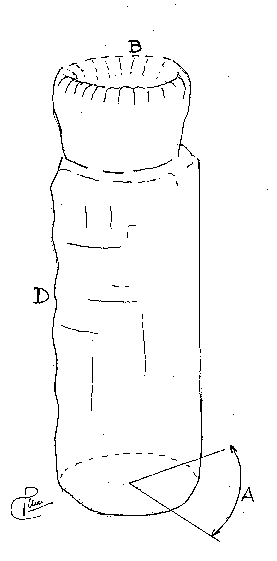
|
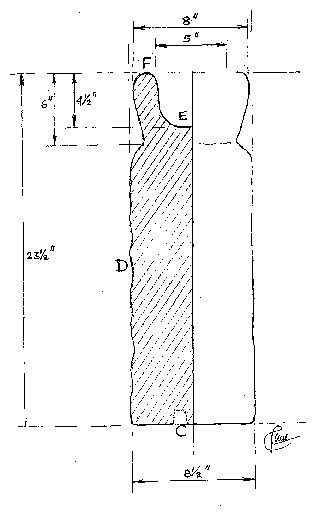
|
The drawings on the left are from the Museum’s archive notes and help give some perspective as to the scale of the stone. The notes that follow are drawn directly from the Museum archive notes:
“The part of the bowl B, which was broken while being unearthed was offered up to the part remaining on the shaft, and was found to form a complete bowl. The inside of the bowl E, and the rim F show no signs of having registered with other stonework such as a tabernacle, which might have rested thereon. The rim is carved with a series of ridges equally spaced around it. |
About three-quarters of the surface of the shaft D is carved, although the pattern of the carving cannot be defined. The remaining quarter is plain. In section the shaft is not circular, and the principle eccentric portion is the plain part, suggesting that the carving was not completed. There is no evidence that any part of the sides of the shaft were ever in contact with any other stonework.
The base of the shaft is flat and there is a spigot hole C about 1½ inches in diameter offset from the centre by about 1½ inches, and filled with lead. This spigot hole suggests that the shaft base fitted to another stone, perhaps of similar section, …..”
All very interesting do I hear you say? So what is the connection to St Mary’s Church? This is where the mystery and the detective work begin. The stone was discovered in the garden of The Old Manor House at the top of the High Street, on the opposite side of the road to the Church in 1969.
In Chapter I of 'Materials for a History of Cricklade', an article on St Mary's Church by a former rector the Rev. F.H. Lovell, mention is made of what is almost certainly the same stone shaft, which the author states was found during the removal of an earlier chancel east window in 1906: pp23/24
“In removing this window, two most interesting stone, originally one, were found immediately it embedded in the wall. These stones (of Coral Rag1) are of peculiar shape and of great age, but their history and purpose is not clear. It is possible that they formed the shaft of a cross in a pre-Norman chancel, and one is hollowed out as though it carried something on it. The stones are preserved in the chapel window, and appear to be the earliest of our relics.”
There are no longer any such stones in St Mary's Church, but since the subject stone was found in a garden almost opposite the church (presumably used at one time as a bird-bath), we may suppose that this is one of the two stones to which the Rev. Lovell referred.
So, if the stone is indeed the one found embedded in the church wall (and from the description this would seem probable) then what was it doing there, and what was its original function? The fact that it was embedded in the church wall suggests that the stone was of significance. The authorities at the time would likely not allow a religious stone
artefact, even if of no further practical use, to be used for general building purposes and so embedding it in a church wall, becoming part of the foundations of the new church, would probably be considered an appropriate place for it.
OK, so that may be why it was there. But what was it used for? It could be the upper part of a stone shaft that was intended to support a tabernacle, for use inside or outside the church, but the absence of any evidence inside the bowl tends to discount this theory.
A possible alternative purpose could be as a font, albeit a very crude and unusual form of such. If the length of the missing second stone brought the bowl rim to a height of about 3' 4" to 3' 6", this would be about the correct height for a font.
There is a viable theory that the first church in Cricklade may have been built soon after the traditional meeting between St Augustine of Canturbury and the Celtic bishops c604, which T.R. Thomson suggested as being held at the place where the Roman road crossed the Hwicce border (Wilts/Glos border) near Cricklade. Thomson also suggested that a bishop of Dorchester (the west Saxon See), Birinus consecrated 634, or Agilbert consecrated 650 as possible founders of a church at Cricklade.
There is strong evidence of St Mary’s Church having Saxon origins and the age and features of this unusual stone suggest that it may have been part of early Saxon font. It may be that antiquarians have encountered a shaft similar to the one at Cricklade and that they may be able to establish the purpose for this interesting relic. For the moment however it is the view of Cricklade Museum’s recently retired Curator that this is probably part of an early Saxon font. Unless, of course, you know otherwise ………
David Tetlow
1 Limestone. Interestingly a recent visitor
to the Museum, an expert is geology, stated that the stone is in fact
Taynton stone rather than Coral Rag. Taynton stone was used in St
Paul’s Cathedral, London. |
|
Do
you have any stories about St Mary's which you could
share
with our readers?
Or
photographs and drawings to illustrate our newsletter?
Contact
Bernadette Yarnold with details.
All
contributions gratefully received. |
Contact us
Chairman: Bernadette Yarnold,
6 Four Acre Close, Ashton Keynes
Secretary: Gerry Dudley, 4 Pleydells, Cricklade
Treasurer: Tony Doyle, 4 Dawes Close, Meysey Hampton, Glos |
Acting
Newsletter Editor:
Clare
Flanagan
9
West Mill Lane
Cricklade
SN6
6JL |
|

